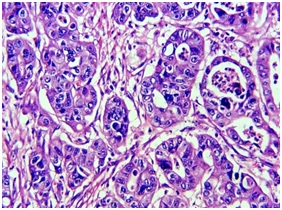The role of tumour infiltrating mast cells (TIM) in gastric carcinoma remains an enigma : Clinicopathological correlation of mast cell density
Abstract
Background: Tumour infiltrating mast cells (TIM) may have pro-tumorigenic and anti-tumorigenic roles based on the mediators released and the outcome of that balance at any given stage could determine the net effect on the progression of the cancer.Their pro-tumorigenic role has been documented in many cancers including prostatic cancer and a beneficial role in breast cancer. Their exact role in gastric cancer is still not very clear. Hence the present study was undertaken to make an attempt to infer the role of tumour infiltrating mast cells in gastric carcinoma by measuring mast cell density and correlating with clinicopathological parameters.
Methods: Tissue from fifty one cases of gastric carcinoma were analysed and routine histological findings were recorded. Mast cells were clearly demonstrated in tissue using Toluidine Blue stain at pH 2.3. Mast cells were counted in the tumour tissue using an eyepiece grid and expressed as no. of cells / per sq. mm, i.e., mast cell density (MCD). Statistical correlation of the mean Mast cell density (MCD) to clinical parameters like age, gender, location of lesion and pathological parameters like histologic type, grade, depth of invasion, lymph node status were analysed for statistical significance.
Results: MCD was statistically significantly higher (Mean MCD +/- S.D:3.48 +/- 2.31) in patient group above 60 years of age compared to patient group below 60 years. MCDwas statistically significantly increased in well differentiated adenocarcinoma (Mean MCD +/- S.D: 7.2 +/- 3.55) stomach compared to moderately differentiated adenocarcinoma and poorly differentiated adenocarcinoma. However, no significant difference in MCD was observed in primary gastric tumour tissue in cases with metastatic deposits in regional lymph nodes and cases without lymph node metastasis.
Conclusions: Our results indicate that the role of mast cells in gastric carcinoma could be pro-tumorigenic in the early stages especially during angiogenesis with an increase in MCD in well differentiated tumours and a relative decrease of mast cells in higher histological grades. The absence of any significant difference of MCD in lymph node positive (for metastatic deposit) and lymph node negative group may indirectly indicate no significant role in later stages of the cancer. These results indirectly show that a balance between pro-tumorigenic and anti-tumorigenic factors is involved in the pathogenesis and progression of gastric carcinoma. The role of mast cells in inflammatory and ulcerative gastric lesions which could be precursor lesions to gastric carcinoma also needs to be considered.
Downloads
References
Ferlay J, Soerjomataram I, Ervik M, Dikshit R, Eser S, Parkin DM.Estimated incidence, mortality and prevalence worldwide [Internet].International Agency for Research on Cancer. Accessed May 4, 2018. Available from: http://globocan.iarc.fr/Default.aspx.
Balkwill F, Mantovani A. Inflammation and cancer: back to Virchow? Lancet 2001;357(9255):539–45.
Crivellato E, Beltrami C alberto, Mallardi F, Ribatti D. Paul Ehrlich’s doctoral thesis: a milestone in the study of mast cells. Br J Haematol 2003; 123(1):19–21.
Kirchhoff D, Bischoff SC, Maurer M, Zollner TM. Mast cells in health and disease: from basic science to clinical application 4-5 July 2008, Stuttgart, Germany. Expert OpinTher Targets 2008; 12(12):1591–4.
Mushtaq MU, Papadas A, Pagenkopf A, Flietner E, Morrow Z, Asimakopoulos F et al. Tumor matrix remodeling and novel immunotherapies: the promise of matrix-derived immune biomarkers.J Immunother Cancer 2018. Jul 3;6(1):65. doi: 10.1186/s40425-018-0376-0.
Beaven MA. Our perception of the mast cell from Paul Ehrlich to now. Eur J Immunol 2009; 39(1):11–25.
Theoharides TC, Conti P. Mast cells: the Jekyll and Hyde of tumor growth. Trends Immunol 2004; 25(5): 235–41.
Berczi L, Tamássy K, Fekete B, Kopper L. Eosinophils and Mast Cells in Helicobacter Pylori Infected Gastric Mucosa. Pathol Oncol Res POR 1996;2(4):229–36.
Nakajima S, Krishnan B, Ota H, Segura AM, Hattori T, Graham DY, et al. Mast cell involvement in gastritis with or without Helicobacter pylori infection. Gastroenterology 1997; 113(3):746–54.
Mukherjee S, Bandyopadhyay G, Dutta C, Bhattacharya A, Karmakar R, Barui G. Evaluation of endoscopic biopsy in gastric lesions with a special reference to the significance of mast cell density. Indian J PatholMicrobiol 2009; 52(1):20–4.
Lazăr D, Raica M, Sporea I, Tăban S, Goldiş A, Cornianu M. Tumor angiogenesis in gastric cancer. Romanian J MorpholEmbryol Rev RoumMorpholEmbryol 2006;47(1):5–13.
Sridharan G, Shankar AA. Toluidine blue: A review of its chemistry and clinical utility. J Oral MaxillofacPathol JOMFP 2012;16(2):251–5.
Epstein JB, Scully C, Spinelli J. Toluidine blue and Lugol’s iodine application in the assessment of oral malignant disease and lesions at risk of malignancy. J Oral Pathol Med 1992;21(4):160–3.
Jiang Y-A, Zhang Y-Y, Luo H-S, Xing S-F. Mast cell density and the context of clinicopathological parameters and expression of p185, estrogen receptor, and proliferating cell nuclear antigen in gastric carcinoma. World J Gastroenterol WJG 2002;8(6):1005–8.
Yano H, Kinuta M, Tateishi H, Nakano Y, Matsui S, Monden T, et al. Mast cell infiltration around gastric cancer cells correlates with tumor angiogenesis and metastasis. Gastric Cancer Off J Int Gastric Cancer Assoc Jpn Gastric Cancer Assoc 1999;2(1):26–32.
Ribatti D, Guidolin D, Marzullo A, Nico B, Annese T, Benagiano V, et al. Mast cells and angiogenesis in gastric carcinoma. Int J Exp Pathol 2010;91(4):350–6.
Ichikura T, Tomimatsu S, Okusa Y, Uefuji K, Tamakuma S. Comparison of the prognostic significance between the number of metastatic lymph nodes and nodal stage based on their location in patients with gastric cancer. J Clin Oncol Off J Am Soc Clin Oncol 1993;11(10):1894–900.



 OAI - Open Archives Initiative
OAI - Open Archives Initiative


